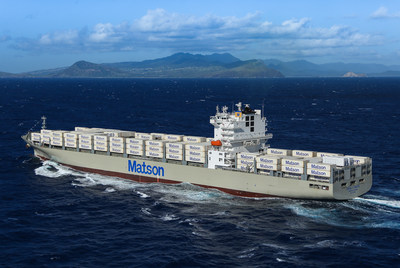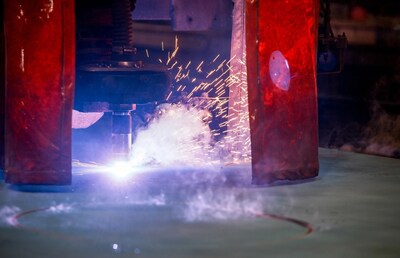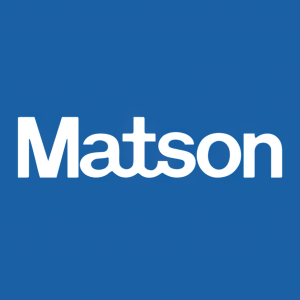MATSON BEGINS CONSTRUCTION ON FIRST OF THREE NEW LNG-POWERED ALOHA CLASS CONTAINERSHIPS
Matson, Inc. (NYSE: MATX) has begun construction on the first of three new Aloha Class containerships at Philly Shipyard in Pennsylvania. This $1 billion investment is part of Matson's long-term decarbonization strategy. The vessels, designed for Hawaii and China-Long Beach Express services, will be Jones Act-compliant and delivered in 2026 and 2027.
The new ships will feature dual fuel engines capable of operating on conventional marine fuels or liquefied natural gas (LNG), along with other green ship technology. With a capacity of 3,600 TEU and speeds exceeding 23 knots, these 854-foot vessels will replace three existing ships in Matson's fleet.
Matson aims to achieve a 40% reduction in Scope 1 greenhouse gas fleet emissions by 2030 and net-zero emissions by 2050. The new ships will be named Makua, Malama, and Makena, continuing Matson's tradition of using Hawaiian names for its vessels.
Matson, Inc. (NYSE: MATX) ha avviato la costruzione del primo di tre nuovi vascelli Aloha Class presso il Philly Shipyard in Pennsylvania. Questo investimento da 1 miliardo di dollari fa parte della strategia di decarbonizzazione a lungo termine di Matson. Le navi, progettate per i servizi Hawaii e China-Long Beach Express, saranno compliant con il Jones Act e verranno consegnate nel 2026 e 2027.
Le nuove navi avranno motori a doppio carburante in grado di operare con condotti marittimi convenzionali o gas naturale liquefatto (GNL), insieme ad altre tecnologie ecologiche. Con una capacità di 3.600 TEU e velocità superiori a 23 nodi, queste navi lunghe 854 piedi sostituiranno tre navi esistenti nella flotta di Matson.
Matson mira a ottenere una riduzione del 40% delle emissioni di gas a effetto serra Scope 1 della flotta entro il 2030 e a raggiungere emissioni nette zero entro il 2050. Le nuove navi saranno chiamate Makua, Malama e Makena, continuando la tradizione di Matson di utilizzare nomi hawaiani per i suoi vascelli.
Matson, Inc. (NYSE: MATX) ha comenzado la construcción del primero de tres nuevos buques de contenedores de clase Aloha en el astillero de Philly en Pennsylvania. Esta inversión de 1.000 millones de dólares es parte de la estrategia de descarbonización a largo plazo de Matson. Los buques, diseñados para los servicios de Hawaii y China-Long Beach Express, serán conformes a la Ley Jones y se entregarán en 2026 y 2027.
Los nuevos barcos contarán con motores de doble combustible capaces de operar con combustibles marinos convencionales o gas natural licuado (GNL), junto con otras tecnologías de barcos ecológicos. Con una capacidad de 3,600 TEU y velocidades superiores a 23 nudos, estos barcos de 854 pies reemplazarán a tres buques existentes en la flota de Matson.
Matson busca lograr una reducción del 40% en las emisiones de gases de efecto invernadero de Alcance 1 por su flota para 2030 y alcanzar emisiones netas cero para 2050. Los nuevos barcos se llamarán Makua, Malama, y Makena, continuando con la tradición de Matson de usar nombres hawaianos para sus embarcaciones.
Matson, Inc. (NYSE: MATX)는 펜실베니아의 필리 조선소에서 첫 번째 Aloha Class 컨테이너선의 건설을 시작했습니다. 이 10억 달러의 투자금은 Matson의 장기 탈탄소화 전략의 일환입니다. 이 선박들은 하와이 및 중국-롱비치 익스프레스 서비스용으로 설계되었으며, Jones Act를 준수하며 2026년과 2027년에 인도될 예정입니다.
새로운 선박들은 기존 해양 연료 또는 액화 천연 가스 (LNG)로 운영할 수 있는 듀얼 연료 엔진을 특징으로 하며, 기타 친환경 선박 기술도 포함됩니다. 3,600 TEU의 용량과 23노트를 초과하는 속도를 자랑하는 이 854피트 길이의 선박들은 Matson의 기존 선박 세 대를 대체할 것입니다.
Matson은 2030년까지 1급 온실가스 배출량을 40% 줄이는 것을 목표로 하며, 2050년까지 탄소 배출 제로 달성을 노리고 있습니다. 새로운 선박의 이름은 Makua, Malama, Makena로 지어져, Matson의 하와이 이름 사용 전통을 이어갑니다.
Matson, Inc. (NYSE: MATX) a commencé la construction du premier de trois nouveaux navires de conteneurs de classe Aloha au Philly Shipyard en Pennsylvanie. Cet investissement d'un milliard de dollars fait partie de la stratégie de décarbonisation à long terme de Matson. Les navires, conçus pour les services Hawaii et China-Long Beach Express, seront conformes à la Jones Act et seront livrés en 2026 et 2027.
Les nouveaux navires seront équipés de moteurs à double combustible capables de fonctionner avec des combustibles marins conventionnels ou du gaz naturel liquéfié (GNL), ainsi que d'autres technologies navales vertes. Avec une capacité de 3 600 TEU et des vitesses dépassant 23 nœuds, ces navires de 854 pieds remplaceront trois navires existants dans la flotte de Matson.
Matson vise à réaliser une réduction de 40 % des émissions de gaz à effet de serre de la flotte de portée 1 d'ici 2030 et des émissions nettes nulles d'ici 2050. Les nouveaux navires seront nommés Makua, Malama et Makena, poursuivant ainsi la tradition de Matson d'utiliser des noms hawaïens pour ses navires.
Matson, Inc. (NYSE: MATX) hat mit dem Bau des ersten von drei neuen Aloha-Class-Containerschiffen im Philly Shipyard in Pennsylvania begonnen. Diese 1 Milliarde Dollar umfassende Investition ist Teil von Matsons langfristiger Dekarbonisierungsstrategie. Die Schiffe, die für die Dienstleistungen Hawaii und China-Long Beach Express konzipiert sind, werden Jones Act-konform sein und 2026 und 2027 ausgeliefert werden.
Die neuen Schiffe werden Dual-Fuel-Motoren besitzen, die in der Lage sind, mit herkömmlichen maritimen Kraftstoffen oder verflüssigtem Erdgas (LNG) zu arbeiten, sowie mit anderen umweltfreundlichen Schiffstechnologien. Mit einer Kapazität von 3.600 TEU und Geschwindigkeiten von über 23 Knoten werden diese 854 Fuß langen Schiffe drei bestehende Schiffe in Matsons Flotte ersetzen.
Matson strebt an, bis 2030 eine Reduktion der Treibhausgasemissionen der Flotte um 40% (Scope 1) zu erreichen und bis 2050 Netto-Null-Emissionen zu erreichen. Die neuen Schiffe werden Makua, Malama und Makena heißen und damit Matsons Tradition fortsetzen, hawaiianische Namen für seine Schiffe zu verwenden.
- Investment of $1 billion in three new LNG-powered containerships
- New vessels designed to operate on both conventional marine fuels and LNG, supporting decarbonization goals
- Ships will have a carrying capacity of 3,600 TEU and operate at speeds over 23 knots
- Vessels will help Matson achieve its 2030 greenhouse gas emissions reduction goal
- New ships will replace three older vessels, potentially improving operational efficiency
- Significant capital expenditure of $1 billion may impact short-term financial performance
Insights
The construction of three new LNG-powered Aloha Class containerships represents a significant step in Matson's fleet modernization and decarbonization strategy. This
The 3,600 TEU capacity and 23+ knot speed of these ships will enhance Matson's service reliability in the Hawaii and China-Long Beach Express routes. This investment not only supports Matson's environmental goals but also strengthens its competitive position in the Jones Act trade lanes. The decision to build at Philly Shipyard, a leading U.S. commercial shipyard, further supports domestic shipbuilding capabilities.
Matson's investment in LNG-powered containerships is a significant move towards reducing the maritime industry's carbon footprint. LNG as a marine fuel can reduce CO2 emissions by up to
This initiative aligns with the broader industry trend towards decarbonization and demonstrates Matson's proactive approach to meeting future environmental regulations. The company's commitment to achieving net-zero Scope 1 GHG emissions by 2050 positions it as a leader in sustainable shipping practices. However, it's important to note that while LNG reduces emissions, it's still a fossil fuel and should be viewed as a transitional solution towards fully renewable energy sources in maritime transport.
The three new Jones Act-compliant vessels, representing an investment of approximately
Like their sisterships, the new vessels will be equipped with dual fuel engines designed to operate on either conventional marine fuels or liquefied natural gas (LNG), as well as other "green ship technology" features, such as a fuel-efficient hull design, environmentally safe double hull fuel tanks, and freshwater ballast systems. While the earlier ships required some modification to operate with LNG, the new ships will be delivered LNG-ready.
The first vessel is expected to be delivered in the fourth quarter of 2026 with subsequent deliveries in 2027.
"Our existing Aloha Class ships are among the fastest, most efficient vessels in the Matson fleet," said Matt Cox, chairman and chief executive officer. "And like their sisterships, these three new vessels will help Matson achieve its 2030 greenhouse gas emissions reduction goal while also providing additional capacity and speed benefitting our
Matson has set corporate goals to achieve a 40 percent reduction in Scope 1 greenhouse gas (GHG) fleet emissions by 2030 and net-zero Scope 1 GHG emissions by 2050.
With a carrying capacity of 3,600 TEU,* the 854-foot Aloha Class vessels are designed to operate at speeds in excess of 23 knots in support of Matson's service hallmark – fast and reliable delivery of goods.
The three new Aloha Class ships will replace three vessels currently deployed in Matson's
Philly Shipyard is a leading
"Today we celebrate not only the beginning of production, but also the return of Matson to Philly Shipyard for our third project together," said Steinar Nerbovik, Philly Shipyard's President and CEO. "We are thrilled to build these next vessels which are expected to help Matson achieve its 2030 greenhouse gas emissions goal, an initiative well-aligned with our commitment to people and planet."
Vessel Names Announced
Matson plans to name the three new containerships Makua, Malama, and Makena. Founded in 1882 as a
Matson's original ships named Makua, Malama, and Makena were all freighters commissioned by the United States Shipping Board (USSB), an emergency agency established by the 1916 Shipping Act to increase the number of
Makua ("mah-KOO-ah") is a Hawaiian word for parent, elder, ancestor, or family.
Malama ("MAH-lah-mah") is a Hawaiian word meaning to care for or protect.
Makena ("Mah-KEN-ah") is a Hawaiian word for abundance.
* TEU = Twenty-foot Equivalent Units, the standard unit of measurement for container capacity
About Matson
Founded in 1882, Matson (NYSE: MATX) is a leading provider of ocean transportation and logistics services. Matson provides a vital lifeline of ocean freight transportation services to the domestic non-contiguous economies of
Investor Relations inquiries: Justin Schoenberg Matson, Inc. 510.628.4234 | News Media inquiries: Keoni Wagner Matson, Inc. 510.628.4534 |
![]() View original content to download multimedia:https://www.prnewswire.com/news-releases/matson-begins-construction-on-first-of-three-new-lng-powered-aloha-class-containerships-302262999.html
View original content to download multimedia:https://www.prnewswire.com/news-releases/matson-begins-construction-on-first-of-three-new-lng-powered-aloha-class-containerships-302262999.html
SOURCE Matson, Inc.










